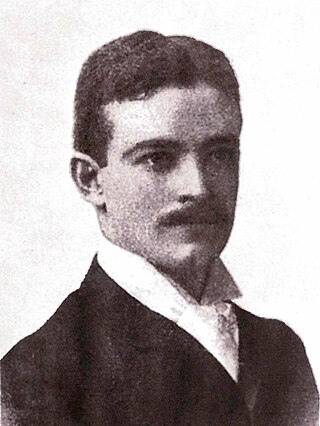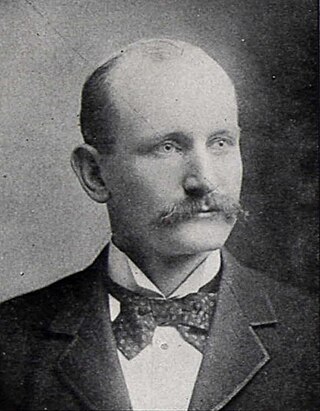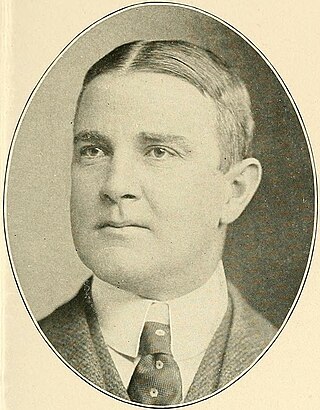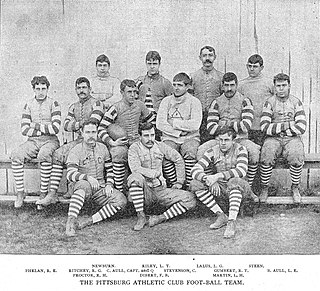
William Walter "Pudge" Heffelfinger, also spelled Hafelfinger, was an American football player and coach. He is considered the first athlete to play American football professionally, having been paid to play in 1892 for the Allegheny Athletic Association.

Knowlton Lyman "Snake" Ames was an American football player and coach. He played for Princeton University from 1886 to 1889, and the Chicago Athletic Association, in 1892. Playing for the Princeton Tigers, Ames was selected to the 1889 College Football All-America Team as a fullback. In 1891 and 1892, he was the head football coach at Purdue University. He is also credited as the first head football coach at Northwestern University.
The Allegheny Athletic Association was an athletic club that fielded the first ever professional American football player and later the first fully professional football team. The organization was founded in 1890 as a regional athletic club in Allegheny, Pennsylvania, which is today the North Side of Pittsburgh.

John Kinport "Sal" Brallier was one of the first professional American football players. He was nationally acknowledged as the first openly paid professional football player when he was given $10 to play for the Latrobe Athletic Association for a game against the Jeanette Athletic Association in 1895.
The Pittsburgh Athletic Club football team, established in 1890, was based in Pittsburgh, Pennsylvania. In 1892 the intense competition between two Pittsburgh-area clubs, the Allegheny Athletic Association and the Pittsburgh Athletic Club, led to William (Pudge) Heffelfinger becoming the first known professional football player. Heffelfinger was paid $500 by Allegheny to play in a game against Pittsburgh on November 12, 1892. As a result, Heffelfinger became the first person to be paid to play football. Allegheny would go on to win the game, 4–0, when Heffelfinger picked up a Pittsburgh fumble and ran it 35 yards for a touchdown. In 1893, Pittsburgh again made history when it signed one of its players, probably halfback Grant Dibert, to the first known pro football contract, which covered all of the team's games for the year.
Benjamin Shenstone "Sport" Donnelly was an American football player and coach. He was the second-ever known professional football player, after Pudge Heffelfinger. He was paid $250 for one game on November 19, 1892 by the Allegheny Athletic Association, for a game against the Washington & Jefferson Presidents football team. The November 19 date was exactly seven days after the team paid Heffelfinger $500 for a game. In 1893, Donnelly was hired by the Allegheny Athletic Association as player-coach, making him the first man to ever coach a known pro team. Heffelfinger once said that Donnelly was the only man that he had played against who "could slug you and at the same time keep his eyes on the ball". Donnelly also served as the second head football coach at the University of Iowa for a single season in 1893, compiling a record of 3–4.
Oliver David Thompson was an early football player at Yale, who played alongside Walter Camp. After his time at Yale, Thompson played, and served as the manager, for the Allegheny Athletic Association. However Thompson is best known for paying Pudge Heffelfinger $500 to play for Allegheny against their rivals, the Pittsburgh Athletic Club. Thompson's historic actions went unnoticed until the 1960s, when an 1892 account ledger prepared by Thompson – while he was manager of the Allegheny Athletic Association – included the line: "Game performance bonus to W. Heffelfinger for playing (cash) $500." The ledger is currently on display at the Pro Football Hall of Fame in Canton, Ohio.

Professor Louis Frederick Kirchner, misnamed in some posthumous sources as William Kirschner, was an early football player and physical instructor for the Pittsburgh Athletic Club. He may, or may not, have been one of the earliest professional football players. Even though he had never played football before 1890, he had the ability to learn and adapt to the game quickly. During the 1890s he was viewed as one of the best offensive linemen in Pennsylvania.
Pro Football: Its Ups and Downs, published in 1934, is a book by Dr. Harry March that was the first ever attempt to write a history of professional American football. March had served in several executive offices with the New York Giants of the National Football League in the late 1920s and was a founder of the second American Football League. The book, while popular and entertaining with some important information and interesting anecdotes, is often viewed as inaccurate by modern sports historians. Jack Cusack, manager of the Canton Bulldogs from 1912 to 1917, summed up the book's flaws by stating; "In my library is a book... entitled Pro Football: Its "Ups and Downs" and in my opinion it is something of a historical novel."

Charles Elmer Aull was an early professional football player. He played professionally for the Pittsburgh Athletic Club. He also played college football from 1889 until 1891 for the Penn State Nittany Lions. He was born in Pittsburgh in 1869. He died in Ohio in 1958.

Augustus Clement Read was a college football player and the captain of the Penn State Nittany Lions football team, and a college shot putter. He was from Delano, Pennsylvania.

John Albert "Burt" Aull was an early football player with the Pittsburgh Athletic Club, prior to the club's hiring of professional football players.

JohnMoore Van Cleve was an American football player and coach, and one of the first known professional players of the sport. After playing college football at Lehigh, he played five seasons for independent teams in or near Pittsburgh and served in 1898 as player-coach for Pittsburgh College, later known as Duquesne University.

Joseph Clifton Trees was a college football player at the University of Pittsburgh, the first athlete to receive an athletic subsidization at the school, and, possibly, an early professional football player. He later made millions of dollars in the oil industry and became a trustee and significant benefactor to the university and its athletic department. His hobbies included philanthropy, scientific research and agriculture. His 2,600-acre (11 km2) estate in Gibsonia, Pennsylvania was devoted to a large extent to fruit trees.

William J. Kountz Jr. was an American businessman and an early football player and manager for the Allegheny Athletic Association. He gained brief fame as a humorist with his "Billy Baxter" letters.

John Moorhead Jr. was an American football player for Yale. He played alongside Walter Camp, the inventor of the modern game, during the late 1870s. He was also a member, and club president, of the Allegheny Athletic Association, an amateur football club which fielded the first recognized professional player Pudge Heffelfinger. When Allegheny formed a football team in 1890, he took over the position of center. Meanwhile a fellow former Yale player, O. D. Thompson, took over as the club's manager and played tackle.

The 1892 Pittsburgh Athletic Club football season was their third season in existence. The team finished with a record of 3–3–1.
American football in Western Pennsylvania, featuring the city of Pittsburgh and surrounding areas, has had a long and storied history, dating back to the early days of the sport. All levels of football, including high school football and college football, are followed passionately, and the area's National Football League (NFL) team, the Pittsburgh Steelers, is consistently one of the sport's most popular teams. Many of the NFL's top stars have come from the region as well, especially those that play quarterback, earning Western Pennsylvania the nickname "Cradle of Quarterbacks".
The Western Pennsylvania Professional Football Circuit was a loose association of American football clubs that operated from 1890 to approximately 1940. Originally amateur, professionalism was introduced to the circuit in 1892; cost pressures pushed the circuit to semi-professional status from about 1920 through the rest of its existence. Existing in some form for 48 years, it was one of the longest-lived paying football loops to operate outside the auspices of the National Football League.

The 1896 Allegheny Athletic Association football season was the sixth and last season of competition for the American football team representing the Allegheny Athletic Association. The team played only two games, on consecutive days, winning both by shutout. The Pro Football Hall of Fame considers the 1896 Allegheny team as the first completely professional football team.













